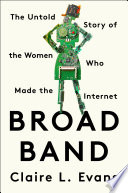

The book begins by tracing the evolution of the internet from its inception as a military project to its current status as a global communication platform. It discusses the early days of ARPANET and how it laid the groundwork for the modern internet. The author emphasizes the transformative impact of the internet on society, economy, and culture. The increasing accessibility of the internet has democratized information and has been a catalyst for innovation across various sectors. The narrative also highlights the challenges that have arisen with this evolution, including issues of privacy, security, and the digital divide.
Continue readingBroadband is portrayed as a critical infrastructure akin to electricity and water. The book discusses how broadband access has become essential for participation in modern society, affecting everything from education to healthcare. It explores the disparities in broadband access, particularly in rural versus urban areas, and how this impacts economic opportunities and quality of life. The author argues that equitable access to broadband is a social justice issue and calls for policy changes to ensure that all communities can benefit from this essential service.
Continue readingThe book delves into how technology has reshaped communication patterns. It examines the rise of social media, instant messaging, and video conferencing, and how these tools have changed the way people interact personally and professionally. The author discusses the advantages and drawbacks of these technologies, including the potential for misinformation and the erosion of privacy. Furthermore, the book highlights the importance of digital literacy in navigating this new communication landscape, advocating for educational initiatives that empower individuals to use technology responsibly.
Continue readingThe author provides insights into the broadband industry, discussing the major players, market dynamics, and regulatory challenges. The book explains how different business models have emerged, including subscription services, advertising-based models, and public-private partnerships. It also covers the role of government in broadband deployment, including funding initiatives and policy frameworks that can either promote or hinder growth. The discussion includes case studies of successful broadband initiatives, illustrating how strategic planning and community involvement can lead to improved access and service.
Continue readingLooking forward, the book explores emerging trends in connectivity, including the rise of 5G technology, satellite internet, and the Internet of Things (IoT). The author discusses how these technologies promise to further transform society by enabling faster and more reliable internet access. However, the book also raises questions about the implications of these advancements, such as increased surveillance, data privacy concerns, and the environmental impact of expanding infrastructure. The author encourages readers to consider the ethical dimensions of technological advancement and to advocate for responsible innovation.
Continue readingBroadband has not only changed how we communicate but has also influenced cultural norms and practices. The book discusses phenomena such as the gig economy, remote work, and the rise of digital content creators. The author examines how these shifts have altered traditional employment models and created new opportunities, while also raising concerns about job security and workers' rights. The narrative emphasizes the need for adaptable policies that can keep pace with these rapid changes in the workforce and society at large.
Continue readingThe final key idea centers around the need for advocacy and informed policy-making in the realm of broadband access and technology. The author argues that as technology continues to evolve, it is crucial for stakeholders—ranging from policymakers to community leaders—to engage in discussions about the future of connectivity. The book calls for a collective effort to address the challenges posed by technological advancements, including ensuring equitable access, protecting user privacy, and fostering an inclusive digital economy. The author encourages readers to become advocates for change in their own communities.
Continue reading